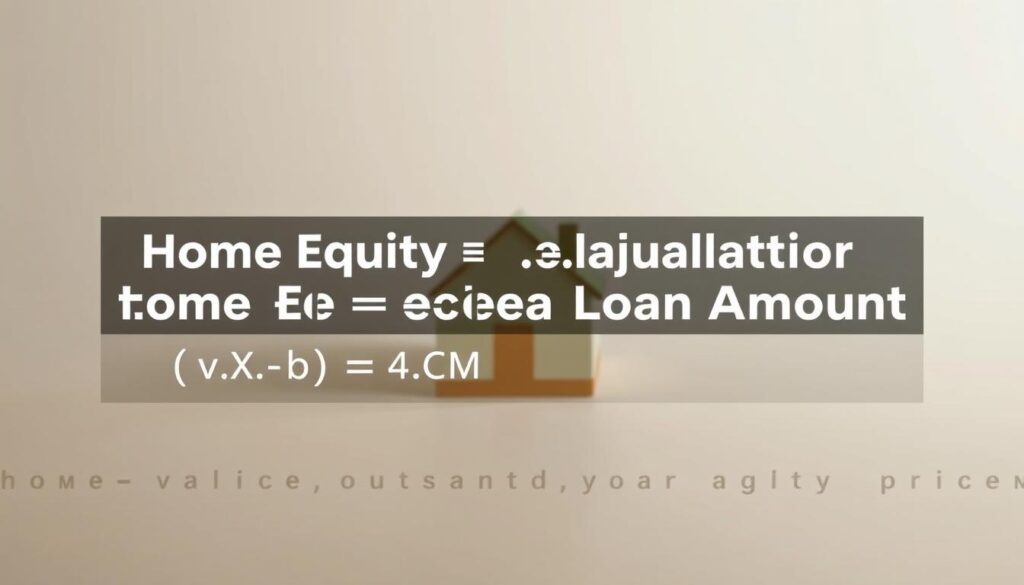Home Equity Loan Rates: Find the Best Deals Today
Did you know the average rate for a 5-year home equity loan is 8.36%? A 15-year loan averages 8.42%, according to Bankrate. These rates are key when deciding to use your home’s equity.
It’s important to understand these loan rates. We’ll look at how they change and what affects them. This will help you find the best home equity loan rates for you.
Key Takeaways
- Current average rates for home equity loans are 8.36% for 5-year terms and 8.42% for 15-year terms.
- Rates can vary based on several factors, including loan terms and market conditions.
- Comparing rates from different lenders is essential to finding the best deal.
- Low home equity loan rates can save you thousands over the life of the loan.
- Understanding the factors that influence home equity loan rates can help you make better financial decisions.
Understanding Home Equity Loans
Learning about home equity loans can help you make smart financial choices. These loans let homeowners borrow money using the equity in their homes.
What Is a Home Equity Loan?
A home equity loan is a big loan based on your home’s value. It has fixed interest rates and monthly payments. It’s like a second mortgage, where you get a one-time payment based on your home’s equity.
U.S. Bank says this loan has predictable payments because of its fixed interest rate. To figure out how much you can borrow, use a home equity rate and payment calculator.
How Do Home Equity Loans Work?
Home equity loans let you use your home’s equity for a big payment. You pay it back over a set time, usually 5 to 15 years, with a fixed interest rate. This means your monthly payments stay the same.
To get the loan, you apply and the lender checks your credit, income, and property value. They decide how much you can borrow and the interest rate.
Benefits of Home Equity Loans
Home equity loans offer a big advantage: you can get a lot of money at a low interest rate. They also come with tax benefits, as the interest paid can be tax-deductible.
Another plus is the structured repayment plan. This helps you manage your finances better. With fixed payments, you can plan your budget easily.
Current Trends in Home Equity Loan Rates
Home equity loan rates have seen changes lately, thanks to the Federal Reserve. Knowing these changes is key for homeowners thinking about a home equity loan.
Rate Increases and Decreases
The Federal Reserve’s decisions have shaped home equity loan rates. When the Fed changes interest rates, so do home equity loan rates. For example, when the Fed lowers rates, home equity loan rates can drop, making borrowing cheaper.
Recent Rate Trends: Bankrate says home equity loan rates are likely to go down as the Fed cuts rates. This is good news for homeowners wanting to use their home’s equity.
Factors Influencing Rates
Many things affect home equity loan rates. These include the economy, inflation, and the housing market. Lenders also look at your credit score, how much you owe on your home, and other financial details when setting rates.
- Economic indicators like GDP growth and unemployment rates
- Inflation rates and their effect on interest rates
- Housing market conditions, including home prices and sales
Regional Variations in Rates
Home equity loan rates differ by region. This is due to local economic conditions, housing market trends, and competition among lenders. It’s important for borrowers to know these differences to get the best rates.
| Region | Average Home Equity Loan Rate | Trend |
|---|---|---|
| Northeast | 6.2% | Stable |
| South | 6.0% | Decreasing |
| West | 6.1% | Increasing |
| Midwest | 5.9% | Stable |
By understanding current trends and what affects them, homeowners can make smart choices about borrowing against their home’s equity.
How to Compare Home Equity Loan Rates
To save money on your home equity loan, compare rates well. You’re not just looking at the interest rate. You’re also considering the loan’s total cost.
Checking Multiple Lenders
Comparing home equity loan rates starts with checking multiple lenders. Each lender has its own rates based on its policies and your credit. Shopping around can save you thousands of dollars over the life of the loan.
For example, U.S. Bank suggests checking with different lenders. Visit banks, credit unions, and online lenders to see what rates are available.
Understanding Terms and Conditions
It’s important to understand your home equity loan’s terms and conditions. The interest rate is just one part. Other factors like fees, repayment terms, and conditions can also affect the loan’s cost.
- Origination fees
- Closing costs
- Repayment period
- Prepayment penalties
Utilizing Online Rate Tools
Online rate tools make comparing home equity loan rates easier. They let you quickly compare rates from various lenders. These tools give you a quick look at current rates and help you choose.
| Lender | Interest Rate | APR | Loan Term |
|---|---|---|---|
| Bank of America | 5.00% | 5.25% | 10 years |
| Wells Fargo | 4.90% | 5.10% | 10 years |
| Quicken Loans | 5.25% | 5.50% | 15 years |
By following these steps and using available tools, you can make a smart choice. The goal is to find a loan that meets your financial needs and goals.
Fixed vs. Variable Home Equity Loan Rates
Choosing between fixed and variable home equity loan rates depends on your financial situation and how much risk you’re willing to take. Fixed home equity loan rates let you plan your payments without surprises. But, variable home equity loan rates might start lower but could go up.
Pros and Cons of Each Rate Type
Fixed rates stay the same, making it easier to budget. This is great when rates are going up. But, if rates drop, you might be stuck with a higher rate unless you refinance.
Variable rates start lower, which means lower payments at first. But, they can change with the market, leading to higher payments if rates go up.
“Fixed home equity loan rates offer predictability, while variable rates may offer lower initial rates but with the risk of rate increases,” according to Bank of America.
When to Choose a Fixed Rate
Go for a fixed rate when rates are low or expected to go up. It lets you know exactly what your payments will be. This is good for long-term planning and budgeting.
- When interest rates are historically low.
- If you expect interest rates to rise in the future.
- When you prefer the stability of fixed monthly payments.
When to Consider a Variable Rate
Variable rates might be better if you’re okay with rate changes and want lower payments at first. Think about your financial situation and how much risk you can handle before choosing a variable rate.
Consider a variable rate if:
- You expect interest rates to fall or remain stable.
- You are comfortable with the risk of potential rate increases.
- You plan to repay the loan quickly, minimizing the impact of rate changes.
Home Equity Loan Eligibility Requirements
Lenders look at several key factors to decide if you can get a home equity loan. Knowing these requirements can help you prepare. It might also improve your chances of getting approved.
Credit Score Considerations
One important factor is your credit score. It shows how good you are at managing credit. For home equity loans, lenders usually want a score of 620 or higher. But, the exact score needed can change based on the lender and the loan type.
Having a good credit score can make you more eligible. It might also get you better loan terms, like lower interest rates. You can boost your score by handling your debt well and paying on time.
Income and Employment Verification
Lenders also check your income and job to make sure you can pay back the loan. They ask for things like pay stubs, W-2 forms, and tax returns.
This process helps lenders see if you can handle the loan payments. It’s important to show you have enough money for both the loan and your other bills.
Property Value Assessment
The property’s value is also key in getting a home equity loan. Lenders want to make sure the property’s value is enough to cover the loan. They do this by getting a home appraisal, which is an independent check of the property’s value.
The loan-to-value (LTV) ratio is important in this check. It shows how much of the property’s value you’re borrowing. For example, if you owe $100,000 on a $200,000 property, the LTV ratio is 50%. Lenders use this ratio to figure out their risk.
| Eligibility Factor | Description | Typical Requirement |
|---|---|---|
| Credit Score | Reflects creditworthiness based on credit history | 620 or higher |
| Income and Employment | Verifies stable income to repay the loan | Stable employment and sufficient income |
| Property Value | Ensures the property’s value secures the loan | Sufficient equity in the property |
How to Calculate Your Potential Loan Amount
The amount you can borrow through a home equity loan depends on several factors. We’ll explore these to help you calculate your potential loan amount.
Lenders usually let you borrow up to 80% to 85% of your home’s value. For example, if your home is worth $200,000, you might borrow up to $160,000 to $170,000. But, the actual amount you can borrow also depends on your home’s equity, your credit score, and the lender’s policies.
Equity Calculation Method
To find your home’s equity, subtract the outstanding mortgage balance from your home’s current market value. For instance, if your home is worth $250,000 and you owe $150,000, your equity is $100,000. The formula is: Equity = Current Market Value – Outstanding Mortgage Balance.

Factors Affecting Loan Amount
Several factors can affect how much you can borrow, including:
- Your credit score: A higher score can qualify you for larger loans at better rates.
- Income and employment verification: Lenders check your income to ensure you can repay the loan.
- Property value: Your home’s value is key in determining your borrowing limit.
- Loan terms: The loan’s length and interest rate also play a role in how much you can borrow.
Loan-to-Value Ratio Explained
The loan-to-value (LTV) ratio is a key metric lenders use. It’s the amount you want to borrow divided by your home’s value. For example, if you want to borrow $120,000 on a $200,000 home, the LTV ratio is 60%. Most lenders have a maximum LTV ratio of 80% to 85% for home equity loans.
| Home Value | Outstanding Mortgage | Equity | LTV Ratio | Potential Loan Amount |
|---|---|---|---|---|
| $200,000 | $100,000 | $100,000 | 50% | $160,000 |
| $300,000 | $150,000 | $150,000 | 50% | $240,000 |
| $400,000 | $200,000 | $200,000 | 50% | $320,000 |
Understanding how to calculate your home equity loan amount and the factors that influence it helps you make better decisions. This way, you can effectively use your home’s equity.
Tips for Securing the Best Rates
To get the best home equity loan rates, you need a smart plan. Homeowners should be proactive and well-informed. We’ll look at key strategies to help you get a good rate on your home equity loan.
Improving Your Credit Score
Boosting your credit score is a great way to get a better loan rate. Lenders see high credit scores as a sign of reliability. To improve your score, pay bills on time, lower your debt, and avoid new credit checks.
Credit Score Tips:
- Regularly check your credit report for mistakes.
- Pay off high-interest debt to lower your credit use ratio.
- Don’t apply for many credit cards or loans at once.
Shopping for Rates
It’s important to compare home equity loan rates. Different lenders offer different rates based on your financial situation. By looking at rates from several lenders, you can find the best one for you.
According to Bankrate, “Improving your credit score and shopping around for rates can help secure the best home equity loan rates.”
| Lender | Interest Rate | Fees |
|---|---|---|
| Bank of America | 6.5% | $1,000 |
| Wells Fargo | 6.2% | $900 |
| Quicken Loans | 6.8% | $800 |
Negotiating with Lenders
Negotiation is key to getting the best rates. If you have offers from several lenders, use them to your advantage. Show your lender your good credit and loyalty to get a better deal.
Negotiation Tips:
- Use competing offers to your advantage.
- Emphasize your financial stability and credit history.
- Be ready to go elsewhere if the deal isn’t right.
Common Mistakes to Avoid with Home Equity Loans
Home equity loans can be very helpful, but there are mistakes to watch out for. It’s important to know these pitfalls to make sure you get a good deal.
U.S. Bank says common mistakes include not shopping around, ignoring fees, and not thinking about future needs. Let’s look at these mistakes to learn how to avoid them.
Failing to Shop Around
Many people don’t compare offers from different lenders. This can mean missing out on better terms or rates. It’s a good idea to check with at least three lenders to find the best home equity loan.
- Check online reviews and ratings to gauge the lender’s reputation.
- Consider the loan terms, including the interest rate and repayment period.
- Evaluate the customer service provided by the lender.
For more on why comparing lenders is important, visit CBS News.
Ignoring Fees and Closing Costs
Another big mistake is ignoring the fees and closing costs of a home equity loan. These costs can quickly add up and change the loan’s total cost.
Key costs to consider:
- Origination fees
- Appraisal fees
- Closing costs
Knowing these costs ahead of time helps you budget better and avoid surprises.

Not Considering Future Financial Needs
It’s also important to think about your future financial needs before taking out a home equity loan. Not doing so can lead to financial trouble if your situation changes.
“It’s essential to assess your financial situation and consider how a home equity loan might impact your future financial stability.”
By thinking about your current and future financial needs, you can decide if a home equity loan is right for you.
The Application Process for Home Equity Loans
Applying for a home equity loan can seem tough. But knowing the steps can make it easier. There are several important stages to go through to get a home equity loan.
Pre-Approval Steps
Getting pre-approved for a home equity loan is a good first step. Pre-approval shows how much you can borrow and shows lenders you’re serious. It involves checking your credit and financial situation.
- Checking your credit score and history
- Assessing your income and employment stability
- Evaluating the current value of your home
This helps you understand if you qualify for a home equity loan.
Required Documentation
After pre-approval, you’ll need to provide documents for your loan. The documents you’ll need include:
- Identification documents (e.g., driver’s license, passport)
- Proof of income (e.g., pay stubs, tax returns)
- Bank statements and other financial records
- Property deeds and insurance information
Having these documents ready can make the application smoother.
Timeline for Approval
The time it takes to get approved varies. It can take from a few weeks to a couple of months. The speed depends on your finances, the lender’s workload, and if more documents are needed.
Knowing these steps and preparing well can help you through the home equity loan application.
What to Do After Securing Your Loan
After getting a home equity loan, managing it well is key to reaching your financial goals. U.S. Bank suggests using the funds wisely.
Effective Fund Management
Start by using your home equity loan funds smartly. Make sure to spend it on what you planned, like home improvements or paying off debts. This way, you get the most out of it.
Repayment Planning
It’s crucial to plan how you’ll pay back the loan. Create a plan that fits your budget. This helps you make payments on time and avoid trouble.
Loan Term Monitoring
Keep an eye on your loan’s details. Watch the interest rate, how long you have to pay it back, and any fees. This ensures the loan stays good for you and you can adjust your plan if needed.









